Page 332 of 510
Notice:Towing your vehicle from the rear
could damage it. Also, repairs would not
be covered by the warranty. Never have
your vehicle towed from the rear.
Dolly Towing
To tow your vehicle with a dolly and two wheels
on the ground, follow these steps:
1. Put the front wheels on a dolly.
2. Put the vehicle in PARK (P).
3. Set the parking brake and then remove the key.
4. Clamp the steering wheel in a straight-ahead
position with a clamping device designed
for towing.
5. Release the parking brake.
332
Page 333 of 510
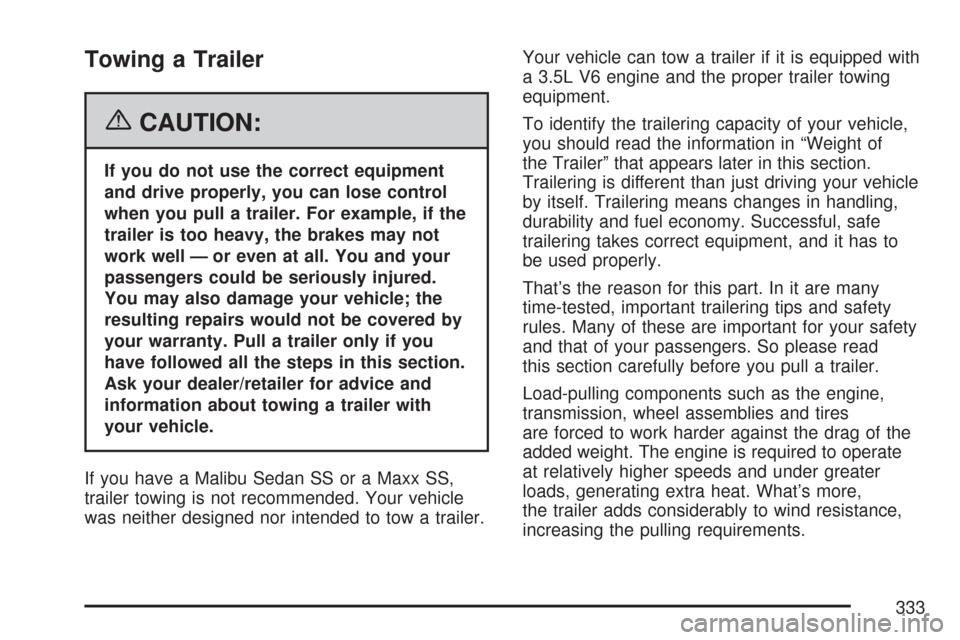
Towing a Trailer
{CAUTION:
If you do not use the correct equipment
and drive properly, you can lose control
when you pull a trailer. For example, if the
trailer is too heavy, the brakes may not
work well — or even at all. You and your
passengers could be seriously injured.
You may also damage your vehicle; the
resulting repairs would not be covered by
your warranty. Pull a trailer only if you
have followed all the steps in this section.
Ask your dealer/retailer for advice and
information about towing a trailer with
your vehicle.
If you have a Malibu Sedan SS or a Maxx SS,
trailer towing is not recommended. Your vehicle
was neither designed nor intended to tow a trailer.Your vehicle can tow a trailer if it is equipped with
a 3.5L V6 engine and the proper trailer towing
equipment.
To identify the trailering capacity of your vehicle,
you should read the information in “Weight of
the Trailer” that appears later in this section.
Trailering is different than just driving your vehicle
by itself. Trailering means changes in handling,
durability and fuel economy. Successful, safe
trailering takes correct equipment, and it has to
be used properly.
That’s the reason for this part. In it are many
time-tested, important trailering tips and safety
rules. Many of these are important for your safety
and that of your passengers. So please read
this section carefully before you pull a trailer.
Load-pulling components such as the engine,
transmission, wheel assemblies and tires
are forced to work harder against the drag of the
added weight. The engine is required to operate
at relatively higher speeds and under greater
loads, generating extra heat. What’s more,
the trailer adds considerably to wind resistance,
increasing the pulling requirements.
333
Page 337 of 510
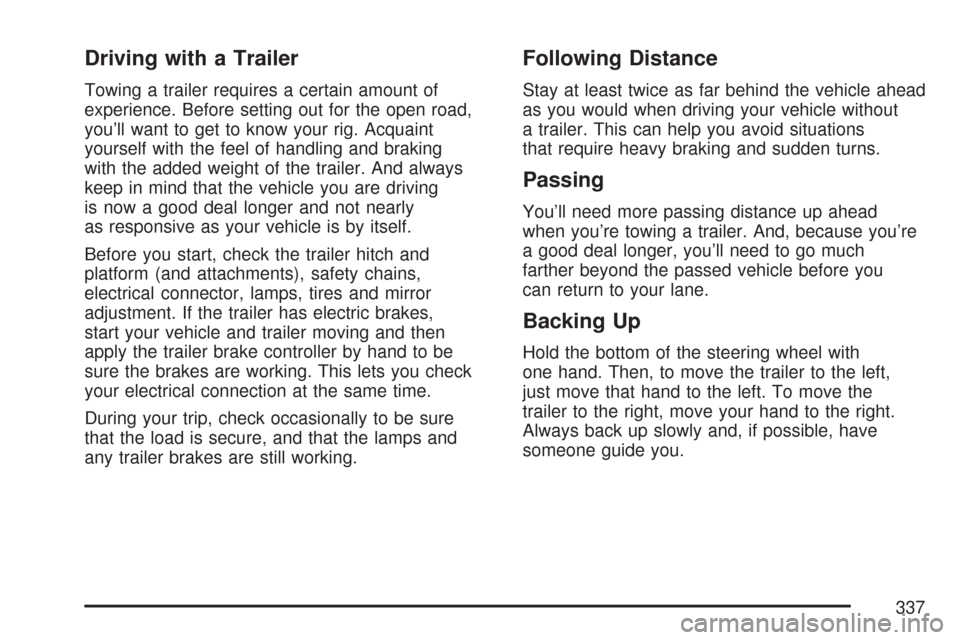
Driving with a Trailer
Towing a trailer requires a certain amount of
experience. Before setting out for the open road,
you’ll want to get to know your rig. Acquaint
yourself with the feel of handling and braking
with the added weight of the trailer. And always
keep in mind that the vehicle you are driving
is now a good deal longer and not nearly
as responsive as your vehicle is by itself.
Before you start, check the trailer hitch and
platform (and attachments), safety chains,
electrical connector, lamps, tires and mirror
adjustment. If the trailer has electric brakes,
start your vehicle and trailer moving and then
apply the trailer brake controller by hand to be
sure the brakes are working. This lets you check
your electrical connection at the same time.
During your trip, check occasionally to be sure
that the load is secure, and that the lamps and
any trailer brakes are still working.
Following Distance
Stay at least twice as far behind the vehicle ahead
as you would when driving your vehicle without
a trailer. This can help you avoid situations
that require heavy braking and sudden turns.
Passing
You’ll need more passing distance up ahead
when you’re towing a trailer. And, because you’re
a good deal longer, you’ll need to go much
farther beyond the passed vehicle before you
can return to your lane.
Backing Up
Hold the bottom of the steering wheel with
one hand. Then, to move the trailer to the left,
just move that hand to the left. To move the
trailer to the right, move your hand to the right.
Always back up slowly and, if possible, have
someone guide you.
337
Page 339 of 510
Parking on Hills
{CAUTION:
You really should not park your vehicle,
with a trailer attached, on a hill. If
something goes wrong, your rig could
start to move. People can be injured,
and both your vehicle and the trailer
can be damaged.But if you ever have to park your rig on a hill,
here’s how to do it:
1. Apply your regular brakes, but don’t shift
into PARK (P) yet.
2. Have someone place chocks under the
trailer wheels.
3. When the wheel chocks are in place,
release the regular brakes until the chocks
absorb the load.
4. Reapply the regular brakes. Then apply
your parking brake and shift into PARK (P).
5. Release the regular brakes.
339
Page 342 of 510

Tires............................................................ 397
Winter Tires.............................................. 398
Tire Sidewall Labeling............................... 399
Tire Terminology and De�nitions............... 403
In�ation - Tire Pressure............................. 406
High-Speed Operation............................... 407
Tire Inspection and Rotation...................... 408
When It Is Time for New Tires.................. 409
Buying New Tires...................................... 410
Different Size Tires and Wheels................ 412
Uniform Tire Quality Grading..................... 412
Wheel Alignment and Tire Balance............ 414
Wheel Replacement.................................. 414
Tire Chains............................................... 416
If a Tire Goes Flat.................................... 417
Changing a Flat Tire................................. 418
Removing the Spare Tire and Tools.......... 419
Removing the Flat Tire and Installing
the Spare Tire....................................... 422
Storing a Flat or Spare Tire and Tools
(Sedan).................................................. 428
Storing a Flat or Spare Tire and Tools
(Sedan SS)............................................ 430Storing a Flat or Spare Tire and Tools
(All MAXX Models)................................. 432
Compact Spare Tire.................................. 434
Appearance Care........................................ 435
Cleaning the Inside of Your Vehicle.......... 435
Fabric/Carpet............................................. 436
Leather...................................................... 437
Ultra Lux Suede........................................ 438
Instrument Panel, Vinyl, and Other
Plastic Surfaces..................................... 438
Care of Safety Belts.................................. 439
Weatherstrips............................................ 439
Washing Your Vehicle............................... 439
Cleaning Exterior Lamps/Lenses................ 440
Finish Care............................................... 440
Windshield and Wiper Blades.................... 440
Aluminum Wheels...................................... 441
Tires......................................................... 441
Sheet Metal Damage................................. 442
Finish Damage.......................................... 442
Underbody Maintenance............................ 442
Chemical Paint Spotting............................ 442
Section 5 Service and Appearance Care
342
Page 383 of 510
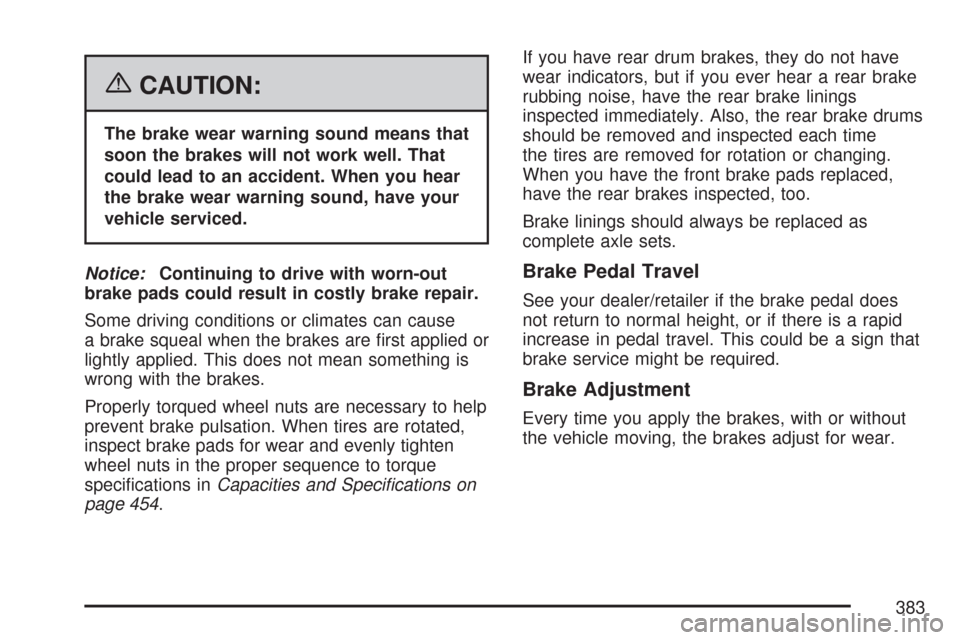
{CAUTION:
The brake wear warning sound means that
soon the brakes will not work well. That
could lead to an accident. When you hear
the brake wear warning sound, have your
vehicle serviced.
Notice:Continuing to drive with worn-out
brake pads could result in costly brake repair.
Some driving conditions or climates can cause
a brake squeal when the brakes are �rst applied or
lightly applied. This does not mean something is
wrong with the brakes.
Properly torqued wheel nuts are necessary to help
prevent brake pulsation. When tires are rotated,
inspect brake pads for wear and evenly tighten
wheel nuts in the proper sequence to torque
speci�cations inCapacities and Speci�cations on
page 454.If you have rear drum brakes, they do not have
wear indicators, but if you ever hear a rear brake
rubbing noise, have the rear brake linings
inspected immediately. Also, the rear brake drums
should be removed and inspected each time
the tires are removed for rotation or changing.
When you have the front brake pads replaced,
have the rear brakes inspected, too.
Brake linings should always be replaced as
complete axle sets.
Brake Pedal Travel
See your dealer/retailer if the brake pedal does
not return to normal height, or if there is a rapid
increase in pedal travel. This could be a sign that
brake service might be required.
Brake Adjustment
Every time you apply the brakes, with or without
the vehicle moving, the brakes adjust for wear.
383
Page 398 of 510
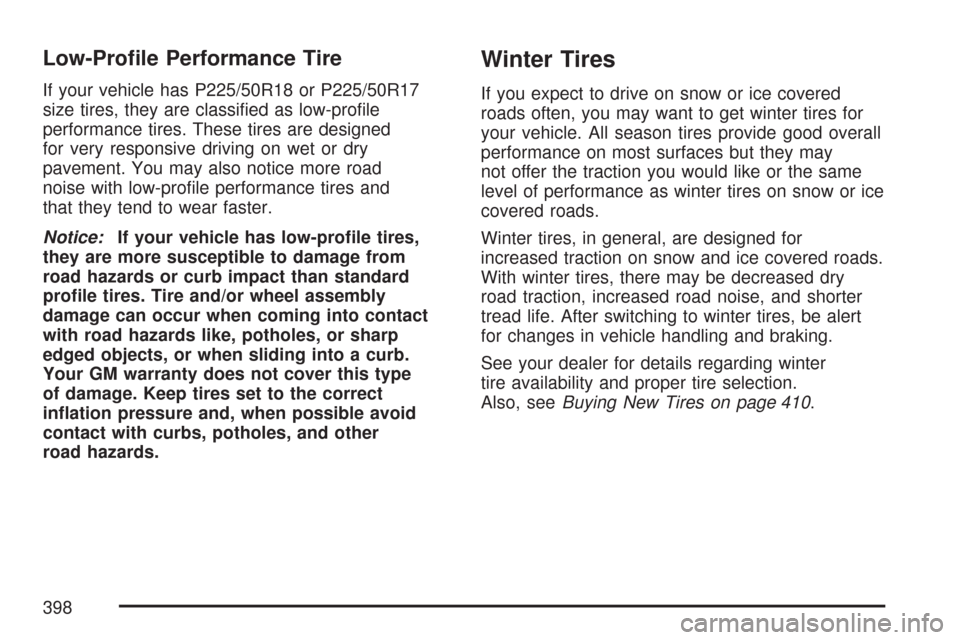
Low-Pro�le Performance Tire
If your vehicle has P225/50R18 or P225/50R17
size tires, they are classi�ed as low-pro�le
performance tires. These tires are designed
for very responsive driving on wet or dry
pavement. You may also notice more road
noise with low-pro�le performance tires and
that they tend to wear faster.
Notice:If your vehicle has low-pro�le tires,
they are more susceptible to damage from
road hazards or curb impact than standard
pro�le tires. Tire and/or wheel assembly
damage can occur when coming into contact
with road hazards like, potholes, or sharp
edged objects, or when sliding into a curb.
Your GM warranty does not cover this type
of damage. Keep tires set to the correct
in�ation pressure and, when possible avoid
contact with curbs, potholes, and other
road hazards.
Winter Tires
If you expect to drive on snow or ice covered
roads often, you may want to get winter tires for
your vehicle. All season tires provide good overall
performance on most surfaces but they may
not offer the traction you would like or the same
level of performance as winter tires on snow or ice
covered roads.
Winter tires, in general, are designed for
increased traction on snow and ice covered roads.
With winter tires, there may be decreased dry
road traction, increased road noise, and shorter
tread life. After switching to winter tires, be alert
for changes in vehicle handling and braking.
See your dealer for details regarding winter
tire availability and proper tire selection.
Also, seeBuying New Tires on page 410.
398
Page 399 of 510
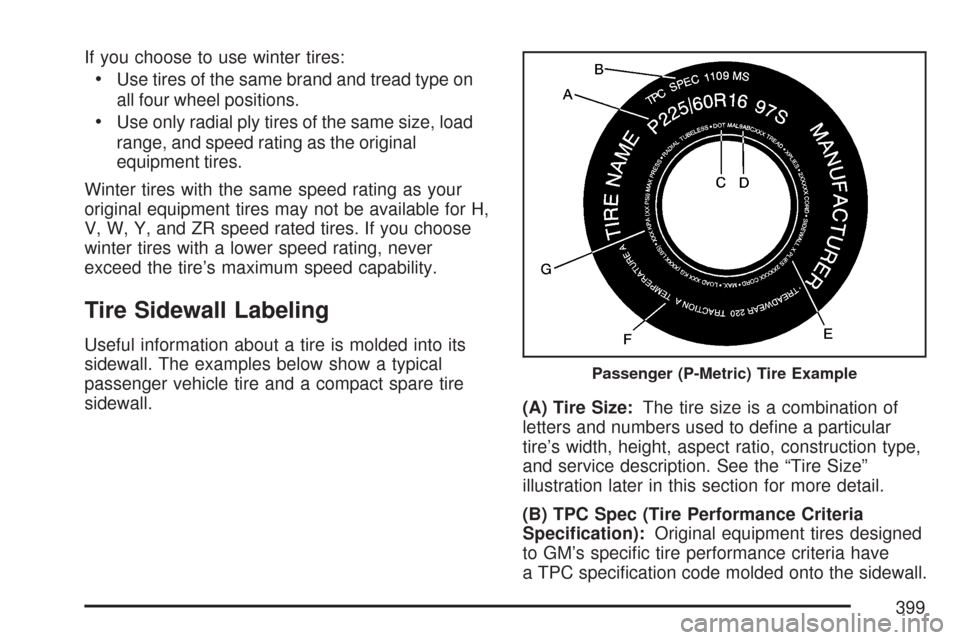
If you choose to use winter tires:
Use tires of the same brand and tread type on
all four wheel positions.
Use only radial ply tires of the same size, load
range, and speed rating as the original
equipment tires.
Winter tires with the same speed rating as your
original equipment tires may not be available for H,
V, W, Y, and ZR speed rated tires. If you choose
winter tires with a lower speed rating, never
exceed the tire’s maximum speed capability.
Tire Sidewall Labeling
Useful information about a tire is molded into its
sidewall. The examples below show a typical
passenger vehicle tire and a compact spare tire
sidewall.
(A) Tire Size:The tire size is a combination of
letters and numbers used to de�ne a particular
tire’s width, height, aspect ratio, construction type,
and service description. See the “Tire Size”
illustration later in this section for more detail.
(B) TPC Spec (Tire Performance Criteria
Speci�cation):Original equipment tires designed
to GM’s speci�c tire performance criteria have
a TPC speci�cation code molded onto the sidewall.
Passenger (P-Metric) Tire Example
399